 Display and Troubleshoot SIP signaling over IP networks in console.
Display and Troubleshoot SIP signaling over IP networks in console.
 SIPp is a free Open Source test tool / traffic generator for the SIP protocol. It includes a few basic SipStone user agent scenarios (UAC and UAS) and establishes and releases multiple calls with the INVITE and BYE methods. It can also reads custom XML scenario files describing from very simple to complex call flows. It features the dynamic display of statistics about running tests (call rate, round trip delay, and message statistics), periodic CSV statistics dumps, TCP and UDP over multiple soc
SIPp is a free Open Source test tool / traffic generator for the SIP protocol. It includes a few basic SipStone user agent scenarios (UAC and UAS) and establishes and releases multiple calls with the INVITE and BYE methods. It can also reads custom XML scenario files describing from very simple to complex call flows. It features the dynamic display of statistics about running tests (call rate, round trip delay, and message statistics), periodic CSV statistics dumps, TCP and UDP over multiple soc
 pv ("Pipe Viewer"), a terminal-based tool for monitoring the progress of data through a pipeline. It can be inserted into any normal pipeline between two processes to give a visual indication of how quickly data is passing through, how long it has taken, how near to completion it is, and an estimate of how long it will be until completion.
pv ("Pipe Viewer"), a terminal-based tool for monitoring the progress of data through a pipeline. It can be inserted into any normal pipeline between two processes to give a visual indication of how quickly data is passing through, how long it has taken, how near to completion it is, and an estimate of how long it will be until completion.
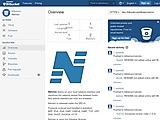 Netvisix listens on your local network interface and visualizes the network packet flow between hosts. Also packet statistics per host are available.
Netvisix listens on your local network interface and visualizes the network packet flow between hosts. Also packet statistics per host are available.
 Snort is the foremost Open Source Intrusion Prevention System (IPS) in the world. Snort IPS uses a series of rules that help define malicious network activity and uses those rules to find packets that match against them and generates alerts for users. Snort can be deployed inline to stop these packets, as well. Snort has three primary uses: As a packet sniffer like tcpdump, as a packet logger — which is useful for network traffic debugging, or it can be used as a full-blown network intrusion pr
Snort is the foremost Open Source Intrusion Prevention System (IPS) in the world. Snort IPS uses a series of rules that help define malicious network activity and uses those rules to find packets that match against them and generates alerts for users. Snort can be deployed inline to stop these packets, as well. Snort has three primary uses: As a packet sniffer like tcpdump, as a packet logger — which is useful for network traffic debugging, or it can be used as a full-blown network intrusion pr
 Snapcast is a multiroom client-server audio player, where all clients are time synchronized with the server to play perfectly synced audio. It's not a standalone player, but an extension that turns your existing audio player into a Sonos-like multiroom solution. Audio is captured by the server and routed to the connected clients. Several players can feed audio to the server in parallel and clients can be grouped to play the same audio stream. One of the most generic ways to use Snapcast is in co
Snapcast is a multiroom client-server audio player, where all clients are time synchronized with the server to play perfectly synced audio. It's not a standalone player, but an extension that turns your existing audio player into a Sonos-like multiroom solution. Audio is captured by the server and routed to the connected clients. Several players can feed audio to the server in parallel and clients can be grouped to play the same audio stream. One of the most generic ways to use Snapcast is in co
 Arping is a util to find out if a specific IP address on the LAN is 'taken' and what MAC address owns it. Sure, you *could* just use 'ping' to find out if it's taken and even if the computer blocks ping (and everything else) you still get an entry in your ARP cache. But what if you aren't on a routable net? Or the host blocks ping (all ICMP even)? Then you're screwed. Or you use arping. Why it's not stupid: Say you have a block of N real IANA-assigned IP-addresses. You want to debug the net and
Arping is a util to find out if a specific IP address on the LAN is 'taken' and what MAC address owns it. Sure, you *could* just use 'ping' to find out if it's taken and even if the computer blocks ping (and everything else) you still get an entry in your ARP cache. But what if you aren't on a routable net? Or the host blocks ping (all ICMP even)? Then you're screwed. Or you use arping. Why it's not stupid: Say you have a block of N real IANA-assigned IP-addresses. You want to debug the net and
 The stunnel program works as SSL encryption wrapper between remote and local network sockets or inetd-started daemons. It adds SSL or TLS functionality to any network service, commonly POP3, IMAP or HTTP servers. Stunnel uses OpenSSL for cryptography. It can itself function as port redirection deamon, or as temporary traffic interceptor, and requires no adaption of the shadowed programs.
The stunnel program works as SSL encryption wrapper between remote and local network sockets or inetd-started daemons. It adds SSL or TLS functionality to any network service, commonly POP3, IMAP or HTTP servers. Stunnel uses OpenSSL for cryptography. It can itself function as port redirection deamon, or as temporary traffic interceptor, and requires no adaption of the shadowed programs.
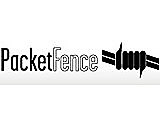 PacketFence is a network access control (NAC) manager. It includes numerous features, including user registration and sanitation, central wireless and cable-network control, BYOD (bring-your-own-device) configuration, 802.1X support, and layer-2 device isolation. PacketFence is useful for managing small to large networks and intranet-access points.
PacketFence is a network access control (NAC) manager. It includes numerous features, including user registration and sanitation, central wireless and cable-network control, BYOD (bring-your-own-device) configuration, 802.1X support, and layer-2 device isolation. PacketFence is useful for managing small to large networks and intranet-access points.
 NetworkManager attempts to keep an active network connection available at all times. The point of NetworkManager is to make networking configuration and setup as painless and automatic as possible. NetworkManager is intended to replace default route, replace other routes, set IP addresses, and in general configure networking as NM sees fit (with the possibility of manual override as necessary). In effect, the goal of NetworkManager is to make networking Just Work with a minimum of user hassle
NetworkManager attempts to keep an active network connection available at all times. The point of NetworkManager is to make networking configuration and setup as painless and automatic as possible. NetworkManager is intended to replace default route, replace other routes, set IP addresses, and in general configure networking as NM sees fit (with the possibility of manual override as necessary). In effect, the goal of NetworkManager is to make networking Just Work with a minimum of user hassle
 Display network interface throughput by second and by minute along with a graph. This is quick and easy to use via a mobile handset or similar device where typing is cumbersome.
Display network interface throughput by second and by minute along with a graph. This is quick and easy to use via a mobile handset or similar device where typing is cumbersome.
 RouterOS configuration instructions and scripts for the MikroTik hAP ax lite router to implement a WiFi client with four (4) wired Ethernet interfaces.
RouterOS configuration instructions and scripts for the MikroTik hAP ax lite router to implement a WiFi client with four (4) wired Ethernet interfaces.
 A machine learning library created to also have powerfull analazys feautures, to have featurues that I would want. Licensed under mit license. To install do pip install okrolearn, to install for cpu do pip install okrolearn==0.2.6
A machine learning library created to also have powerfull analazys feautures, to have featurues that I would want. Licensed under mit license. To install do pip install okrolearn, to install for cpu do pip install okrolearn==0.2.6
 Query and Visualize the network graph of your GitHub repositories, followers, stargazers, and forks (using GraphQL and D3).
Query and Visualize the network graph of your GitHub repositories, followers, stargazers, and forks (using GraphQL and D3).
 MndpTray is a Windows utility that allows you to monitor and manage MikroTik devices on your network from the system tray. The information is broadcast using the MikroTik Discovery Protocol (MNDP), which allows MikroTik RouterOS devices to discover other MikroTik RouterOS devices on the same network segment. This makes it possible for Mndptray to provide information about the host to other MikroTik RouterOS devices and for other MikroTik RouterOS devices to retrieve this information and display
MndpTray is a Windows utility that allows you to monitor and manage MikroTik devices on your network from the system tray. The information is broadcast using the MikroTik Discovery Protocol (MNDP), which allows MikroTik RouterOS devices to discover other MikroTik RouterOS devices on the same network segment. This makes it possible for Mndptray to provide information about the host to other MikroTik RouterOS devices and for other MikroTik RouterOS devices to retrieve this information and display
 Welcome to the NAS Homepage. The Network Audio System is a network transparent, client/server audio transport system. It can be described as the audio equivalent of an X server. Enjoy!
Welcome to the NAS Homepage. The Network Audio System is a network transparent, client/server audio transport system. It can be described as the audio equivalent of an X server. Enjoy!
 ModemManager is a system daemon which controls WWAN (2G/3G/4G/5G) devices and connections. Alongside NetworkManager, ModemManager is the default mobile broadband management system in most standard GNU/Linux distributions (Debian, Fedora, Ubuntu, Arch Linux…), and is also available in custom systems built with e.g. buildroot, yocto/openembedded or ptxdist. ModemManager may also be used in routers running openwrt (integrated with netifd as a new protocol handler), or to manage both voice and dat
ModemManager is a system daemon which controls WWAN (2G/3G/4G/5G) devices and connections. Alongside NetworkManager, ModemManager is the default mobile broadband management system in most standard GNU/Linux distributions (Debian, Fedora, Ubuntu, Arch Linux…), and is also available in custom systems built with e.g. buildroot, yocto/openembedded or ptxdist. ModemManager may also be used in routers running openwrt (integrated with netifd as a new protocol handler), or to manage both voice and dat
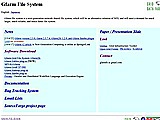 Gfarm is a network shared filesystem and alternative to NFS, but optimized for reliability, scaling and access from wide area network. It can federate local disks of network-connected PCs and compute nodes in several clusters, and supports explicit replica location control by users. Plugins exist for FUSE, Zabbix, Hadoop, Samba, MPI-IO, GridFTP, S3 MinIO, Nextcloud, Spack and a Linux kernel module is under development.
Gfarm is a network shared filesystem and alternative to NFS, but optimized for reliability, scaling and access from wide area network. It can federate local disks of network-connected PCs and compute nodes in several clusters, and supports explicit replica location control by users. Plugins exist for FUSE, Zabbix, Hadoop, Samba, MPI-IO, GridFTP, S3 MinIO, Nextcloud, Spack and a Linux kernel module is under development.
 Netgraphp is a php script which uses LLDP information to traverse SNMP servers in a network and produce a graphical map of different hosts and connections in the network. The graph is produced with the graphviz dot syntax and graphviz can be used to produce different file formats like .png or .eps. All connections to be identified must have LLDP support at both ends and SNMP support at least at one end. Most high end switches have built in support for SNMP and LLDP. Computer hosts need something
Netgraphp is a php script which uses LLDP information to traverse SNMP servers in a network and produce a graphical map of different hosts and connections in the network. The graph is produced with the graphviz dot syntax and graphviz can be used to produce different file formats like .png or .eps. All connections to be identified must have LLDP support at both ends and SNMP support at least at one end. Most high end switches have built in support for SNMP and LLDP. Computer hosts need something
 Turbulence is a general BEEP server built on top of Vortex Library, that provides many ready to use features to ease development and deployment of BEEP applications. Turbulence is extensible through modules (mod-tls, mod-sasl, mod-python, among others) and allows to implement server side profiles that are used and combined later with other profiles through run time configuration. Turbulence is written to make it easy to develop and deploy BEEP profiles, allowing developers to provide a conveni
Turbulence is a general BEEP server built on top of Vortex Library, that provides many ready to use features to ease development and deployment of BEEP applications. Turbulence is extensible through modules (mod-tls, mod-sasl, mod-python, among others) and allows to implement server side profiles that are used and combined later with other profiles through run time configuration. Turbulence is written to make it easy to develop and deploy BEEP profiles, allowing developers to provide a conveni
 OPNsense is an open source, easy-to-use and easy-to-build FreeBSD based firewall and routing platform. OPNsense includes most of the features available in expensive commercial firewalls, and more in many cases. It brings the rich feature set of commercial offerings with the benefits of open and verifiable sources. OPNsense started as a fork of pfSense® and m0n0wall in 2014, with its first official release in January 2015. The project has evolved very quickly while still retaining familiar aspe
OPNsense is an open source, easy-to-use and easy-to-build FreeBSD based firewall and routing platform. OPNsense includes most of the features available in expensive commercial firewalls, and more in many cases. It brings the rich feature set of commercial offerings with the benefits of open and verifiable sources. OPNsense started as a fork of pfSense® and m0n0wall in 2014, with its first official release in January 2015. The project has evolved very quickly while still retaining familiar aspe
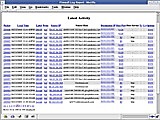 Webfwlog is a Web-based firewall log reporting and analysis tool. It supports IPv6, as well as geoip data for ips using maxmind's geoip databases. It allows users to design reports to use on logged firewall data in whatever configuration they desire. Included are sample reports as a starting point. Reports can be sorted with a single click, or "drilled-down" all the way to the packet level, and report definitions saved for later use. Supported log formats are netfilter, ipfilter, ipfw, ipchains,
Webfwlog is a Web-based firewall log reporting and analysis tool. It supports IPv6, as well as geoip data for ips using maxmind's geoip databases. It allows users to design reports to use on logged firewall data in whatever configuration they desire. Included are sample reports as a starting point. Reports can be sorted with a single click, or "drilled-down" all the way to the packet level, and report definitions saved for later use. Supported log formats are netfilter, ipfilter, ipfw, ipchains,
 What is it? A nifty little utility for pinning commands, applications or links to the system tray. ExeQt goes even further and provides network facilities so that your custom actions can be transfered, accesed and used from computers around the world or computers around your house. How does it work? ExeQt uses the system's native tray to display groups of actions with the things the user loves most such as their documents, the folder with pictures of cats or that site that lets you see how you
What is it? A nifty little utility for pinning commands, applications or links to the system tray. ExeQt goes even further and provides network facilities so that your custom actions can be transfered, accesed and used from computers around the world or computers around your house. How does it work? ExeQt uses the system's native tray to display groups of actions with the things the user loves most such as their documents, the folder with pictures of cats or that site that lets you see how you
 Trottinett was written to allow a laptop computer to quickly switch between a wired and a wifi connection, optionally using the same MAC address for both interfaces.
Trottinett was written to allow a laptop computer to quickly switch between a wired and a wifi connection, optionally using the same MAC address for both interfaces.
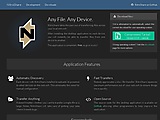 NitroShare is a simple desktop file sharing application. It automatically discovers peers on the local network, provides speedy transfers, and supports any file type. Furthermore is available on all major platforms.
NitroShare is a simple desktop file sharing application. It automatically discovers peers on the local network, provides speedy transfers, and supports any file type. Furthermore is available on all major platforms.
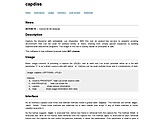 Capdiss is a runtime environment for reading capture files (pcap, pcap-ng). It defines a simple event-driven API for Lua scripts. The aim of capdiss is to provide a comfortable environment for packet manipulation, where an analyst has to write less code, to do more, in a type-safe language. To achieve that, capdiss embeds powerful, yet minimalistic, scripting language Lua, and supports the native packet dissection framework Coroner.
Capdiss is a runtime environment for reading capture files (pcap, pcap-ng). It defines a simple event-driven API for Lua scripts. The aim of capdiss is to provide a comfortable environment for packet manipulation, where an analyst has to write less code, to do more, in a type-safe language. To achieve that, capdiss embeds powerful, yet minimalistic, scripting language Lua, and supports the native packet dissection framework Coroner.
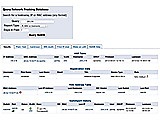 NetDB can inventarize and historize MAC address allocation on network switches and ARP tables on routers. It stores those using MySQL. It supports extensive switch, VLAN and vendor code reports, or tracks static IP addresses, and record neighbor discover. It provides a CLI interface and a web interface, or generate CSV lists.
NetDB can inventarize and historize MAC address allocation on network switches and ARP tables on routers. It stores those using MySQL. It supports extensive switch, VLAN and vendor code reports, or tracks static IP addresses, and record neighbor discover. It provides a CLI interface and a web interface, or generate CSV lists.
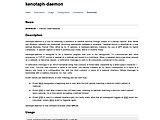 kenotaph-daemon is a tool for detecting a presence of network devices through means of a packet capture. Both Wired and Wireless networks are supported, assuming appropriate hardware is available. Targeted device is identified by a user defined Berkeley Packet Filter, either by its IP address or Hardware address, however the use of BPF allows for higher complexity. A packet capture is done in promiscuous mode, and/or in monitor mode. kenotaph-daemon is designed to be a 'daemon' program that run
kenotaph-daemon is a tool for detecting a presence of network devices through means of a packet capture. Both Wired and Wireless networks are supported, assuming appropriate hardware is available. Targeted device is identified by a user defined Berkeley Packet Filter, either by its IP address or Hardware address, however the use of BPF allows for higher complexity. A packet capture is done in promiscuous mode, and/or in monitor mode. kenotaph-daemon is designed to be a 'daemon' program that run
 The goal of IP-Link is to see the relationships between different IP from network traffic capture, thus quickly for a given address with the IP that communicates the most. IP-Link offers several visualization methods.
The goal of IP-Link is to see the relationships between different IP from network traffic capture, thus quickly for a given address with the IP that communicates the most. IP-Link offers several visualization methods.
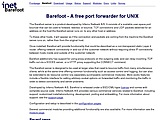 The Barefoot server is a scalable user-space port bouncer that can be used to forward, or bounce, TCP connections and UDP packets destined for an address on the host on which the Barefoot server runs to any other host or address. To these other hosts, it will appear as if the connection and packets are coming from the machine on which the Barefoot server runs, rather than from the original host. The Barefoot server has support for using proxy protocols on the outgoing side, and can relay incomin
The Barefoot server is a scalable user-space port bouncer that can be used to forward, or bounce, TCP connections and UDP packets destined for an address on the host on which the Barefoot server runs to any other host or address. To these other hosts, it will appear as if the connection and packets are coming from the machine on which the Barefoot server runs, rather than from the original host. The Barefoot server has support for using proxy protocols on the outgoing side, and can relay incomin
 TunnelIt is a simple tool that uses the TUN/TAP driver to tunnel Ethernet networks over IP connections. Its simple command line interface is meant to resemble "netcat" where it is logical to do so.
TunnelIt is a simple tool that uses the TUN/TAP driver to tunnel Ethernet networks over IP connections. Its simple command line interface is meant to resemble "netcat" where it is logical to do so.
|